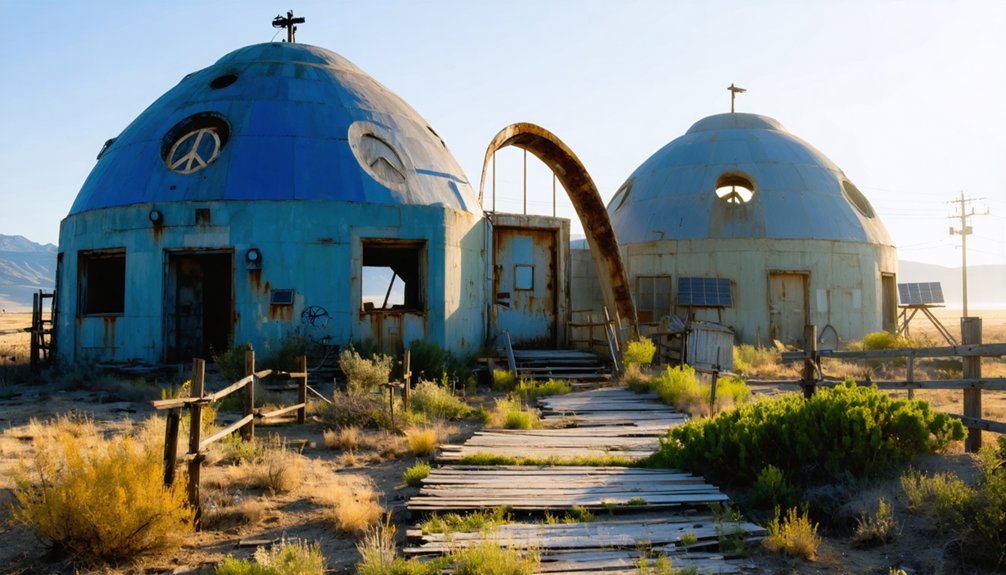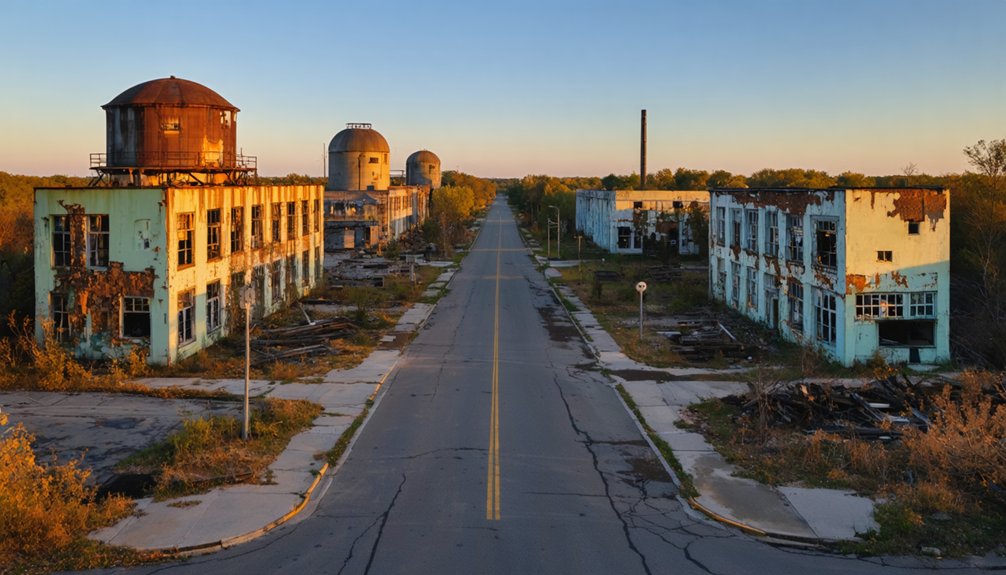When exploring abandoned utopian settlements, first research the community’s philosophical foundations and historical context through scholarly sources. Always secure explicit permission from property owners and verify land status to avoid trespassing. Document your discoveries thoughtfully using wide-angle shots for context and close-ups for architectural details, while respecting these sites as cultural resources rather than mere photographic opportunities. The following guidance illuminates the ethical framework necessary for responsible historical exploration.
Key Takeaways
- Secure permission from property owners before exploring abandoned settlements to avoid trespassing violations.
- Research the historical context and philosophical underpinnings of communities like Oneida or New Harmony before visiting.
- Document sites respectfully through photography during optimal lighting conditions without disturbing artifacts or structures.
- Prioritize safety by wearing protective gear and assessing structural integrity before entering any abandoned buildings.
- Connect with local historical societies to gain deeper insights and possibly access guided tours of preserved utopian communities.
Research Before You Set Foot: Understanding the Community’s Vision and Decline
Before starting an exploration of America’s abandoned utopian settlements, you’ll need to develop a thorough understanding of the community’s original vision and the factors that precipitated its decline.
Research the philosophical underpinnings—whether transcendentalism, Christian millenarianism, or socialism—that shaped the community’s governance and social structures.
Investigate the historical context of the settlement’s formation, particularly during the 19th century when utopian experiments flourished. Many communities like Brook Farm (1841-1847) collapsed due to economic unsustainability despite ambitious community ideals.
Others, including Oneida with its complex marriage system, dissolved from internal factionalism and external pressures.
Look for sites that were established by figures like Orson S. Murray, who founded Fruit Hills in 1845 as an expression of his radical abolitionist principles.
Primary sources such as archival newspapers, scholarly theses, and anthropological reports will provide invaluable insights into both the community’s aspirational vision and pragmatic failures—essential context for respectfully exploring these memorial sites to America’s experimental social heritage.
At least 119 communities were established across America between 1800-1859 by idealists seeking to create collectivist paradises away from conventional society.
With the historical foundation established, we now face the practical challenges of exploring these fading monuments to American utopianism.
Secure explicit permission from property owners—even dilapidated structures remain legally protected. Verify ownership through county assessors before visiting to avoid trespassing complications.
Always respect property rights—abandoned doesn’t mean unowned. Research ownership before exploring to stay on the right side of the law.
Implement essential safety precautions: wear protective clothing, assess structural integrity, carry emergency supplies, and inform someone of your itinerary.
The ethical considerations extend beyond your physical presence; document without disturbing artifacts, follow established pathways, and leave no trace of your visit.
When sharing your discoveries digitally, exercise discretion by withholding precise locations of vulnerable sites and obtaining necessary permissions.
Remember that these ruins aren’t merely photographic opportunities but repositories of human aspirations and struggles—cultural artifacts deserving preservation through conscientious exploration. When exploring sites like Historic Zoar Village, take advantage of the educational signage for self-guided tours to better understand the historical context of these communities. Many sites like New Harmony showcase innovative building techniques that were revolutionary for their time period.
Capture the Experience: Documentation Techniques That Respect Historical Significance
Documenting abandoned utopian settlements requires a methodical approach that balances technical proficiency with historical reverence. Your visual storytelling should commence during ideal lighting conditions—early morning or late afternoon—using wide-angle shots to capture contextual layouts alongside close-up details of architectural elements.
Employ immersive documentation techniques by recording panoramic views that situate the settlement within its landscape. Maintain a detailed field notebook while simultaneously recording audio observations.
For thorough preservation, utilize technological tools like GPS mapping and, where permitted, drone photography for aerial perspectives. Consider how these settlements often incorporated central plazas for community gatherings, reflecting their societal ideals.
Always prioritize ethical practices: avoid disturbing artifacts, document only accessible areas, and properly attribute historical sources. Share your findings with local historical societies, contributing to collective knowledge while respecting these sites as cultural resources rather than merely photogenic ruins. When visiting sites like Llano del Rio Colony, be especially attentive to remaining structures located five miles east of Pearblossom in California’s Antelope Valley.
Your documentation serves as essential preservation of America’s experimental communities.
Frequently Asked Questions
Are Metal Detectors Allowed at Abandoned Utopian Settlement Sites?
You’re barking up the wrong tree. Metal detector regulations typically prohibit artifact recovery techniques at abandoned utopian settlements without explicit permission from landowners or government agencies managing these historically significant properties.
How Do I Identify Authentic Artifacts Versus Modern Debris?
You’ll distinguish authentic artifacts from debris through artifact dating techniques: examine patina patterns, handcraft irregularities, period-appropriate materials, and stratigraphic context. Modern debris classification typically reveals synthetic components and mass-production markers.
What Legal Permissions Are Needed Beyond Basic Trespassing Concerns?
As fate would have it, you’ll need permits required for historic sites, photography/filming, research access, and environmental entry. Always secure explicit permission from private property owners beyond basic trespassing concerns.
Can Children Safely Participate in Utopian Settlement Explorations?
Children can participate with strict adult supervision in designated safe zones. You’ll need to establish exploration guidelines that mitigate structural hazards, wildlife encounters, and hazardous materials while prioritizing child safety throughout your visit.
How Do Seasonal Changes Affect Accessibility and Visibility of Ruins?
Seasonal weather effects dramatically transform your experience; summer foliage conceals ruins, while autumn and winter enhance structural visibility. You’ll encounter muddy spring paths, icy winter obstacles, and ideal access during changing periods.
References
- https://www.bunkhistory.org/resources/exploring-the-midwests-forgotten-utopian-communes
- https://floridapress.blog/2017/12/05/the-archaeology-of-utopian-and-intentional-communities/
- https://fee.org/articles/the-dark-side-of-paradise-a-brief-history-of-americas-utopian-experiments-in-communal-living/
- https://escholarship.org/content/qt283035c5/qt283035c5.pdf
- https://www.atlasobscura.com/lists/12-abandoned-utopias-that-didnt-last
- https://en.wikipedia.org/wiki/Utopia
- https://www.saturdayeveningpost.com/2018/10/home-perfect-home-americas-pursuit-of-utopia/
- https://www.atlasobscura.com/categories/utopias
- https://en.wikipedia.org/wiki/List_of_American_utopian_communities
- https://courses.ischool.berkeley.edu/i247/s17/reports/abandoned_report.pdf



